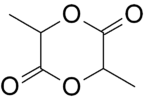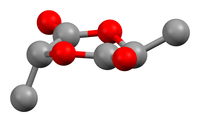Lactide
| Lactide | ||
|---|---|---|
 | ||
 Crystal structure of (R,R)-lactide.[1] | ||
 Crystal structure of meso-lactide.[2] Positions of the hydrogen atoms were not reported. | ||
| Other names Dilactid, (R,R)-3,6-Dimethyl-1,4-dioxan-2,5-dion, (S,S)-3,6-Dimethyl-1,4-dioxan-2,5-dion, (meso)-3,6-Dimethyl-1,4-dioxan-2,5-dion, (R,R)-2,5-Dimethyl-3,6-dioxo-1,4-dioxan, (S,S)-2,5-Dimethyl-3,6-dioxo-1,4-dioxan, (meso)-2,5-Dimethyl-3,6-dioxo-1,4-dioxan | ||
| Identifiers | ||
| CAS number | 4511-42-6 [(S,S)-Lactide] | |
| Properties | ||
| Molecular formula | C6H8O4 | |
| Molar mass | 144.13 g mol−1 | |
| Melting point | 95 - 97 °C [(S,S)-Lactide and (R,R)-Lactide][3] | |
| Solubility in water | Hydrolyses to lactic acid[3] | |
| Solubility | soluble in chloroform, methanol slightly soluble in benzene | |
| Hazards | ||
| R-phrases | R36/37/38 | |
| S-phrases | S26 S37/39 | |
| Except where noted otherwise, data are given for materials in their standard state (at 25 °C (77 °F), 100 kPa) | ||
| Infobox references | ||
Lactide is the cyclic di-ester of lactic acid, i.e., 2-hydroxypropionic acid. Lactic acid cannot form a lactone as other hydroxy acids do because the hydroxy group is too close to the carboxylic group. Instead, lactic acid first forms a dimer, which is similar to a 5-hydroxyacid. The dimer contains a hydroxy group at a convenient distance from the carboxylic group for the formation of a lactone. Indeed, the dimer readily forms a six-membered cyclic diester known as lactide. Lactides may be prepared by heating lactic acid in the presence of an acid catalyst.
In general, a lactide is the cyclic diester, i.e., the di-lactone of two molecules of any 2-hydroxycarboxylic acid.
Stereoisomers
Lactic acid is chiral; two enantiomeric forms, (R)-lactic acid and (S)-lactic acid, may exist. Thus, lactide formed from two equivalents of lactic acid consists of two stereocenters. Three different stereoisomers of lactide are known:
 (R,R)-Lactide (left above), (S,S)-lactide (right above) and meso-lactide (below)
(R,R)-Lactide (left above), (S,S)-lactide (right above) and meso-lactide (below)
Polymerization
Lactide can be polymerized to polylactic acid (polylactide) using suitable catalysts, with either syndiotactic or a heterotactic stereocontrol, to give materials with many useful properties:[4]
References
- ↑ Van Hummel, G. J.; Harkema, S.; Kohn, F. E.; Feijen, J. (1982). "Structure of 3,6-dimethyl-1,4-dioxane-2,5-dione [D-,D-(L-,L-)lactide]". Acta Crys. B38 (5): 1679. doi:10.1107/S0567740882006840.
- ↑ Chisholm, Malcolm H.; Eilerts, Nancy W.; Huffman, John C.; Iyer, Suri S.; Pacold, Martha; Phomphrai, Khamphee (2000). "Molecular Design of Single-Site Metal Alkoxide Catalyst Precursors for Ring-Opening Polymerization Reactions Leading to Polyoxygenates. 1. Polylactide Formation by Achiral and Chiral Magnesium and Zinc Alkoxides, (η3-L)MOR, Where L = Trispyrazolyl- and Trisindazolylborate Ligands". J. Am. Chem. Soc. 122 (48): 11845. doi:10.1021/ja002160g.
- ↑ 3.0 3.1 3.2 Römpp Online Chemielexikon Version 3.3 aufgerufen am 25. März 2009
- ↑ R. Auras; L.-T. Lim; S. E. M. Selke; H. Tsuji (2010). Poly(lactic acid): Synthesis, Structures, Properties, Processing, and Applications. Wiley. ISBN 978-0-470-29366-9.
